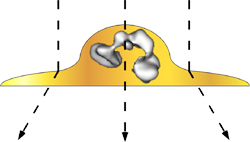
Simple Electron Microscopy Primer
For many types of microscopy, the contrast of the sample is too poor for the human eye to easily differentiate edges and features of the sample. In order to improve contrast, several techniques are used. For light microscopy, phase contrast microscopy is an often used technique. In this method, the incoming light suffers a phase shift as it interacts with the sample. Because the shifted wave interferes with the rest of the beam, contrast is created, and edges stand out. Another common contrast enhancement method uses stains to preferentially highlight some parts of the sample over others. Common stains include colored dyes and highly absorbent materials. For stains to be effective, they have to preferentially bind to some parts of the sample, thereby allowing the differentiation of different parts.
In electron microscopy, staining is usually done with heavy metal salts commonly derived from molybdenum, uranium, or tungsten. Heavy ions are used since they will readily interact with the electron beam and produce phase contrast. A small drop of the sample is deposited on the carbon coated grid, allowed to settle for approximately one minute, blotted dry if necessary, and then covered with a small drop of the stain (for example 2% uranyl acetate). After a few seconds, this drop is also blotted dry, and the sample is ready for viewing.

As explained earlier, the interaction of the electron beam with the sample generates contrast in the image. In negative stain microscopy, the electron beam primarily interacts with the stain. When stain is added to a sample, the stain surrounds the sample but is excluded from the volume occupied by the sample; hence the use of the term 'negative stain'. As Figure 1 shows, a well-stained sample is uniformly covered by the stain. When the electron beam (arrows) passes through the sample, it will be deflected by its interactions with the sample and stain. Since the protein sample excludes stain, the deflection of the electron beam through protein (center arrow) is less than that through stain rich regions (outer arrows). Electrons that are highly deflected by the stain are then filtered out by the objective aperture located below the sample. Depending on the size of the aperture, the quantity of electrons that are culled out will vary and determine the contrast and resolution of the image.
Benefits:
Drawbacks:
Preparation Techniques: Cryo Freezing